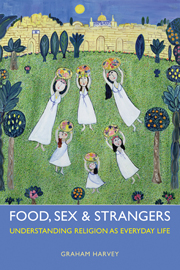Book contents
- Frontmatter
- Dedication
- Contents
- Preface
- 1 Of god and goats
- 2 Religioning elsewhere
- 3 Christianity is not a religion
- 4 Talking like a pirate
- 5 Real world
- 6 Doing violence with impunity
- 7 Respecting relations
- 8 Things full of meaning
- 9 Purity and pilgrimages
- 10 Enchantment and emplacement
- 11 Christians do religion like other people
- 12 Religion is etiquette in the real world
- Bubliography
- Index
10 - Enchantment and emplacement
- Frontmatter
- Dedication
- Contents
- Preface
- 1 Of god and goats
- 2 Religioning elsewhere
- 3 Christianity is not a religion
- 4 Talking like a pirate
- 5 Real world
- 6 Doing violence with impunity
- 7 Respecting relations
- 8 Things full of meaning
- 9 Purity and pilgrimages
- 10 Enchantment and emplacement
- 11 Christians do religion like other people
- 12 Religion is etiquette in the real world
- Bubliography
- Index
Summary
Paganism is a new religion that is evolving within the modernist West, drawing on older repertoires to engage with contemporary concerns. These facts generate some basic questions in the prehistory of this chapter: are tradition, hierarchical authority, unified ideology, and community definitive of religion? Is it legitimate to claim membership of something that should be identified as a religion while knowingly inventing cosmologies and rituals, developing individual practices, and not committing to an agreed creed? In what ways do the disparate practices and interests of Pagans cohere into a recognizable unity? Given that Paganism undoubtedly began in the matrix of modernism, how has it become something other than another kind of Protestant modernism (i.e. something disenchanted and ideas-focused)? If questions like those underlie this chapter, what is it about Paganism that justifies its use as a lens through which to approach the larger question of redefining religion? Taking cues from and following clues in the work of colleagues, I will argue that Paganism is more deserving of the label “religion” than Christianity-as-belief-system is.
I propose that observing Pagans doing what they do can provide valuable data for redefining religion. Precisely because this religion has evolved within modernity but refuses disenchantment, it encourages me to consider whether enchantment is a feature of all religions. Because Pagans experiment with different ways of assembling together, while also experimenting with different assemblages of sources and performances, I am inspired to wonder about the role of fluidity, hybridity and experimentation in all religions.
- Type
- Chapter
- Information
- Food, Sex and StrangersUnderstanding Religion as Everyday Life, pp. 171 - 186Publisher: Acumen PublishingPrint publication year: 2013



